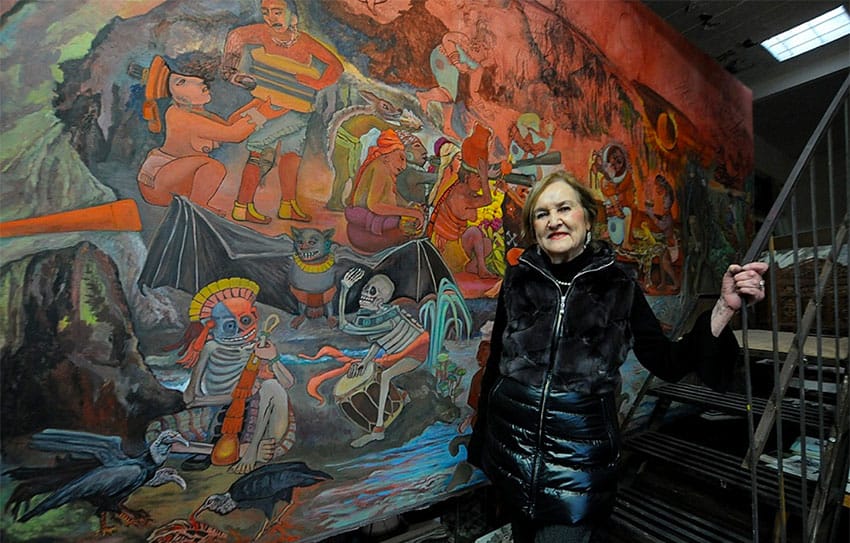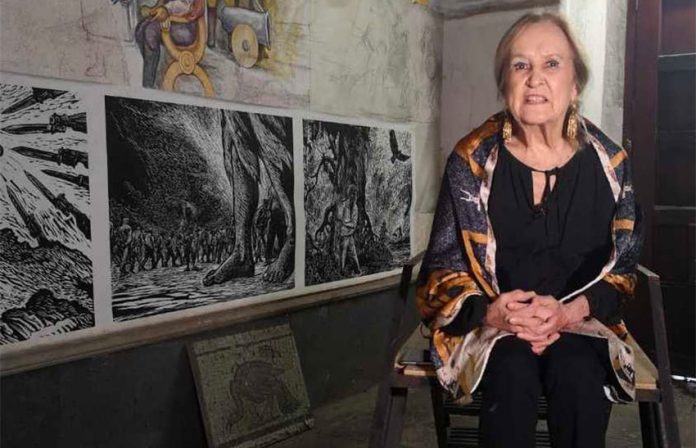Rina Lazo Wasem, the last living assistant to muralist Diego Rivera, has died at the age of 96.
Born in Guatemala City in 1923, Lazo won a scholarship to study art in Mexico. She could have studied anywhere, but chose “La Esmeralda,” the National School of Painting, Sculpture and Engraving, specifically for the opportunity to meet and work with Rivera and Frida Kahlo. That scholarship included a plane ride to Mexico City, something special in 1946.
Little did Lazo know that she would not only have the chance to meet Rivera and Kahlo, but her life would be forever connected with theirs.
Lazo began her studies in Mexico like any other student at La Esmeralda. She stated in an interview in the summer of 2019 that she initially found it hard to break into the various social circles of Mexican students. Her very first friends turned out to be Americans studying on the GI Bill.
After taking a number of classes in different fields, she decided to focus on mural painting, in part because she did not expect to be in Mexico more than the year and a half of her scholarship.

Her first mural class was with Andrés Sánchez Flores, who had worked as an assistant to Rivera. Impressed with her dedication and discipline, he recommended her as an assistant to his maestro even though she had been there only a few months. She became part of a group that worked on Rivera’s mural Sunday Dream at the Alameda Park, painted on the wall at the then Hotel del Prado.
Her workdays there were long, waking up before dawn to take a bus from the new Polanco neighborhood to the worksite and heading home the same way as late as midnight. During the time she began not only to absorb Rivera’s painting style and techniques, but also much of his artistic theory, in particular that art needed to be for the people and have an important message for them.
Lazo quickly stood out among all the assistants and got Rivera’s attention. He called her “a painter of great talent, my right hand, and the best of my assistants.” She worked with Rivera as an assistant for the next 10 years until his death in 1957.
Before then, her life became intertwined with his socially. His acceptance of her as an artist broke just about all social barriers for her. She was a regular guest of Rivera and Kahlo, meeting Mexico City’s artistic, intellectual and political classes. She also met her husband through the famous couple.
Arturo García Bustos was one of Los Fridos, a group of four disciples of Frida Kahlo, who painted with her at the Blue House in Coyoacán, where the couple met. Later, they married and moved into what is called the La Malinche House (the home built by Spanish conquistador Hernán Cortés for his indigenous interpreter, advisor and lover, La Malinche) to be near their teachers.
At that time, the house was in ruins so renovating and preserving the old mansion became a lifelong project for the couple and is now a national heritage site.
Rivera’s death did not mean the end to Lazo’s career. She continued to paint canvas works, but is best known for her murals in Mexico and Guatemala. Her work in Guatemala includes Tierra Fértil (Fertile Land) at the San Carlos University Museum.
Her best-known work in Mexico is a replica of the Bonhampak Mayan murals at the Museum of Anthropology in Mexico City, done in 1964, along with another mural in the same museum based on the Popol Vuh. Her murals had social and political themes, while her canvas works focused on portraits, landscapes and still lifes.
Interestingly, Lazo never really considered herself a “foreigner” in Mexico. She preferred to emphasize the cultural similarities between Guatemala and Mexico, especially the Mayan heritage they both share. She had both Mexican and Guatemalan citizenship.
She received many awards for her work during her lifetime, including the Order of the Quetzal from the Guatemalan government. On December 7, 2019, the National Institute of Fine Arts organized a homage to the artist’s life at the museum housing the first mural she did with Diego Rivera so many decades before.
She was extremely generous with interviews and never seemed to tire of keeping the memory of Mexican muralism alive. Her gratitude to Rivera and Kahlo never diminished over her long life.
Despite her age, her death came as a surprise to friends, family and colleagues because she was extremely active up to the day before.
She is survived by one daughter, Rina García Lazo.
Mexico News Daily
